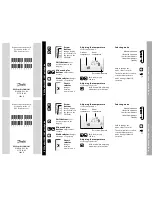
16.4 Troubleshooting Based on the Operation and Conditions of the Servomotor
16-55
16
Maintenance
16.4
Troubleshooting Based on the Operation and Conditions of the Servomotor
This section provides troubleshooting based on the operation and conditions of the Servomo-
tor, including causes and corrections.
Problem
Possible Cause
Confirmation
Correction
Reference
Servomotor
Does Not
Start
The control power supply is
not turned ON.
Measure the voltage
between control power
supply terminals.
Turn OFF the Servo
System. Correct the
wiring so that the con-
trol power supply is
turned ON.
–
The main circuit power sup-
ply is not turned ON.
Measure the voltage
across the main circuit
power input terminals.
Turn OFF the Servo
System. Correct the
wiring so that the main
circuit power supply is
turned ON.
–
The I/O signal connector
(CN1) pins are not wired cor-
rectly or are disconnected.
Turn OFF the Servo Sys-
tem. Check the wiring
condition of the I/O signal
connector (CN1) pins.
Correct the wiring of
the I/O signal connec-
tor (CN1) pins.
The wiring for the Servomo-
tor Main Circuit Cables or
Encoder Cable is discon-
nected.
Check the wiring condi-
tions.
Turn OFF the Servo
System. Wire the cable
correctly.
–
There is an overload on the
Servomotor.
Operate the Servomotor
with no load and check
the load status.
Turn OFF the Servo
System. Reduce the
load or replace the Ser-
vomotor with a Servo-
motor with a larger
capacity.
–
The type of encoder that is
being used does not agree
with the setting of Pn002
(2002h) = n.
X
(Encoder
Usage).
Check the type of the
encoder that is being
used and the setting of
Pn002 (2002h) =
n.
X
.
Set Pn002 (2002h) =
n.
X
according to
the type of the encoder
that is being used.
There is a mistake in the
input signal allocations
(Pn50A (250Ah), Pn50B
(250Bh), Pn511 (2511h), and
Pn516 (2516h)).
Check the input signal
allocations (Pn50A
(250Ah), Pn50B (250Bh),
Pn511 (2511h), Pn516
(2516h)).
Correctly allocate the
input signals (Pn50A
(250Ah), Pn50B
(250Bh), Pn511
(2511h), Pn516
(2516h)).
The Servo ON command
(Enable Operation com-
mand) was not sent.
Make sure the Servo ON
command (Enable Opera-
tion command) is set to
Operation Enabled.
Set the correct value
for the Servo ON com-
mand (Enable Opera-
tion command).
−
The torque limit reference is
too small.
Check the torque limit ref-
erence.
Increase the torque
limit reference.
−
The operation mode is not
set.
Check to see if
modes of
operation
(6060h) is set.
Set
modes of operation
(6060h) correctly.
−
A software limit is active.
Check to see if the target
position exceeds a soft-
ware limit.
Specify a target posi-
tion that is within the
software limits.
−
EtherCAT communications
are not established.
Check to see if the Ether-
CAT indicator shows the
Operational state.
Place the EtherCAT
communications in the
Operational state.
−
The P-OT (Forward Drive
Prohibit) or N-OT (Reverse
Drive Prohibit) signal is still
OFF.
Check the P-OT and N-
OT signals.
Turn ON the P-OT and
N-OT signals.
Continued on next page.















































